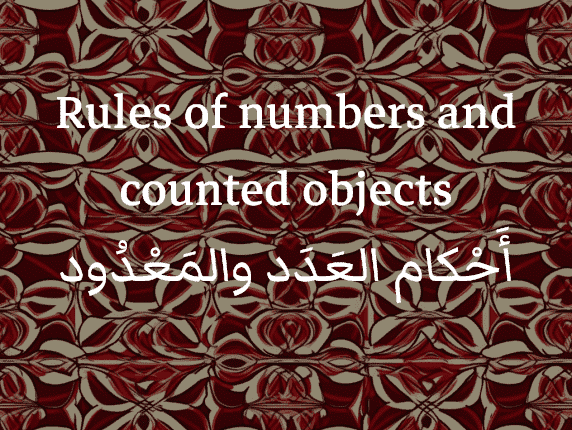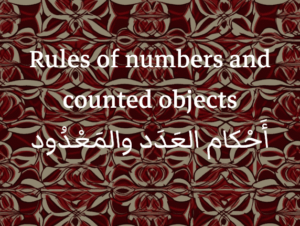Rules of numbers and counted objects / أَحْكام العَدَد والمَعْدُود

(Before studying this part check => Elementary section: Cardinal numbers & Intermediate section: Ordinal numbers)
Cardinal numbers
Understanding Arabic number rules is essential for navigating the elaborate system of cardinal number agreement, which is dictated by three key factors: the gender of the counted nouns, the quantity being expressed, and the specific grammatical declension involved.
- The number may or may not agree with the gender of the counted object depending on its value.
- In contrast to English cardinal numbers, Arabic numerals are nouns (apart from 2 being an adjective and 1 with both forms of a noun and adjective). Following this, the preceding object will not be in the nominative case but take on different ending cases according to its numerical value. Moreover, the object that is quantity beyond two may or may not be plural depending on what number it follows in succession.
The gender agreement of the number / العدد
| المَعْدُود Counted object | جِنْس العَدَد Gender of the number | |
|---|---|---|
| 1 – 2 | same | |
| 3 to 10 | Opposite to the gender of the counted object in its singular form | |
| 11 – 12 | same | |
| 13 to 19 | 1st part (unit): opposite 2nd part (ten): same | |
| tens 20 to 90 | Never change according to gender | |
| compound number 21 to 99 | 1st part (unit) same 2nd part: never change no matter the gender | |
| hundred | Never change according to gender | |
| thousand | ||
Unit from 1 to 10, 100 & 1000
- 1 – 2: the gender of the number corresponds to the counted object
| 1 woman | أِمْرَأَةٌ واحِدةٌ |
| 2 men | رَجُلانِ اِثْنانِ |
- 3 to 10: the number has the opposite gender of the counted object in the singular form
| 4 men | أَرْبَعةُ رَجُلٍ |
| 6 women | سِتُّ اِمْرَأَةٍ |
- 100 to 1000: doesn’t change according to gender
| 100 men | مِئَةُ رَجُلٍ |
| 100 women | مِئَةُ اِمْرَأَةٍ |
| 1000 men | أَلْفُ رَجُلٍ |
| 1000 women | أَلْفُ اِمْرَأَةٍ |
The compound number from 11 to 19
- 11 – 12: Both parts of the number agree with the gender of the counted object
| 11 men | أَحَدَ عَشَرَ رَجُلاً |
| 12 women | اِثْنَتَا عَشَرَةَ اِمْرَأَةً |
Note: the feminine of اِثْنان is اِثْنَتان
- 13 to 19: the 1st part of the number is of the opposite gender to the counted object while the 2nd part agrees with the gender of the counted object
| 14 men | أَرْبَعَةَ عَشَرَ رَجُلاً |
| 17 women | سَبْعَ عَشَرَةَ اِمْرأَةً |
Tens (20 to 90)
- Never change according to gender
| 20 women | عِشْرونَ اِمْرَأةً |
| 50 men | خَمْسُونَ رَجُلاً |
Compound number constructed with the conjunction wāw 21 to 99
- The unit agrees with the object while the ten doesn’t change according to the genre
| 21 men | واحِدٌ وَعِشْرونَ رَجُلاً |
| 35 women | خَمْسٌ وَثَلاثُونَ اِمْرَأَةً |
| 68 men | ثَمانِيةٌ وَسِتُّونَ رَجُلاً |
| 92 women | اِثْنَتانِ وَتِسْعُونَ اِمْرَأَةً |
Agreement in number and noun case of the counted object / المَعْدود
| العَدَد Number | المَعْدود The counted object | |
|---|---|---|
| المَحَلّ الإِعْرابيّ Noun case | العَدَد Number | |
3 to 10 | (مَجْرور (مُضاف إِلَيْهِ genitive (2nd term of annexation) | جَمْع (plural) |
| 11 to 99 | (مَنْصُوب (تَمْيِيز accusative (tamyīz) | مُفْرَد (singular) |
| hundred | (مَجْرور (مُضاف إِلَيْهِ genitive (2nd term of annexation) | |
| thousand | ||
1 – 2
Mentioning the counted object alone (without the number) is sufficient. We can add the number to put emphasis. In this case, the number will agree with the gender of the counted object.
| المُؤَنَّث Feminine | المُذَكّر Masculine |
|---|---|
| امْرَأَة A woman | رَجُل A man |
| امْرَأَة واحِدة One woman | رَجُلان اِثْنان Two men |
| امْرَأَتان اِثْنتان Two women | رَجُلان Two men |
Note: the feminine of اِثْنان is اِثْنَتان
3 to 10
The counted object is considered to be the 2nd term of annexation (while the number is the 1st term) it is then in the indefinite genitive case and takes the plural form.
| 3 men | ثَلاثَةُ رَجُلٍ |
| 7 women | سَبْعُ اِمْرَأَةٍ |
11 to 99
The counted object is considered to be tamyīz (تَمْيِيز) it is then in the indefinite accusative case and takes the singular form.
| 16 men | سِتَّةَ عَشَرَ رَجُلاً |
| 19 women | تِسْعَ عَشَرَةَ اِمْرأَةً |
| 47 men | سَبْعَةٌ وَأَرْبَعُونَ رَجُلاً |
| 58 women | ثَمانٍ وَخَمْسُونَ اِمْرَأَةً |
100 and above
After hundreds and thousands, the counted object is considered to be the 2nd term of annexation (while the number is the 1st term) it is then in the indefinite genitive case and takes the plural form.
| 100 men | مِئَةُ رَجُلٍ |
| 1000 women | أَلْفُ اِمْرَأَةٍ |
Rule for a complex number
- In a complex number, the counted object will follow the rules specific to the digit immediately preceding it:
| 2026 women | أَلْفان وَسِتٌّ وَعِشْرونَ اِمْرأَةً |
| 1817 men | أَلْفٌ وَثَمانُمِئَةٍ وَسَبْعَةَ عَشَرَ رَجُلاً |
| 5700 women | خَمْسَةُ آلافٍ وَسَبْعُمِئَةِ اِمْرَأَهٍ |
| 9504 men | تِسْعَةُ آلافٍ وَخَمْسُمِئِةٍ وَأَرْبَعَةُ رِجالٍ |
Note: For any number greater than 100 and whose last two digits are 01 or 02 (101, 102, 1001, 2002 etc) we will use circumlocutions such as:
1001 Nights (name of a collection of Middle Eastern folk tales compiled, widely known as the Arabian Nights)
أَلْف لَيْلة وَلَيْلة102 days مِئِة يَوم وَيَوْمان
With a definite counted object
When the counted object is definite, its number becomes an adjective, except for compound numbers (11 to 19). Consequently, the number agrees in case, definiteness, and gender (if possible) with the noun. This construction is mandatory if the noun is defined by annexation (إِضافة):
| The 30 women | النِساءُ الثَلاثونَ |
| The 8 men | الرِجالُ الثمانيةُ |
| His 3 cats | القِطَطَهُ الثَلاثةُ |
| The director’s 7 cars | سَيّاراتُ المُدِيرِ السَبْعُ |
For compound numbers between 11 and 19 (indeclinable), we will follow the same construction as for indefinite nouns (tamyīz):
| The 14 men | الأَرْبَعَةَ عَشَرَ رَجُلاً |
| The 19 women | التِسْعَ عَشَرَةَ اِمْرَأَةً |
Note: If the counted object has several adjectives, the number will be placed first, before the other qualifiers:
The 3 big women النساءُ الثَلاثُ الكَبِيرات The 5 small men الرِجال الخَمْسةُ الصِغارُ
Ordinal numbers
Ordinals are usually formed as adjectives, inflecting to match the gender and case of the counted object; however, for numbers 11-19 the ordinal remains in the accusative case.
1st
First (أَوّل) is an elative (اِسْم تَفْضِيل) which is constructed as an adjective and then agrees in every aspect with the counted object.
| The 1st man | الرَجُلِ الأَوَّلُ |
| The 1st woman | المْرأةٍ الأُولى |
It can also be constructed as the 1st term of an annexation completed by a noun; it will then have the same meaning.
| The 1st man | أَوَّلُ رَجُلٍ |
| The 1st woman | أَوَّلُ اِمْرأةٍ |
Note: آخِر meaning ‘last’ is an active participle (اِسم الفاعِل) constructed in the same way
The last year آخِرُ سَنّةٍ = السَنة الآخرةُ
2nd to 10th
The ordinals on the pattern فاعِل are adjectives then agree in every aspect with the counted object
| 2nd man | الرَجُلُ الثاني |
| 8th woman | المَرْأَةُ الثامِنةُ |
11th to 19th
Both parts of the number agree with the object being counted.
| 18th man | الرَجُلُ الثامِنَ عَشَرَ |
| 13th woman | المَرْأَةُ الثالِثةَ عَشَرَةَ |
20th and above
The unit agrees with the object counted while the ten has only one writing regardless of gender.
| 21st man | الَرَجُل الحادي وَالعِشْرُونَ |
| 66th woman | المَرْأَةُ السادِسةُ وَالسِتُّونَ |
| 75th man | الرَجُلُ الخامِسُ وَالسَبْعُونَ |
| 33rd woman | المَرْأَةُ الثالِثةُ وَالثَلاثُونَ |
Rules of numbers and counted objects

Learn the rules of numbers and counted objects in Arabic with examples and explanations. Improve your understanding of Arabic grammar and syntax for better communication.
Course Provider: Organization
Course Provider Name: ArabiKey
Course Provider URL: https://arabikey.com
5

Responses